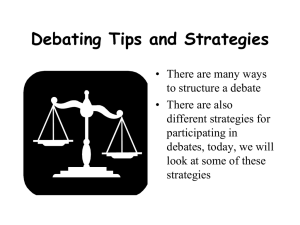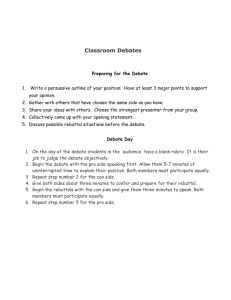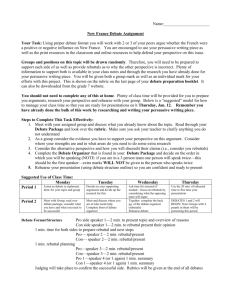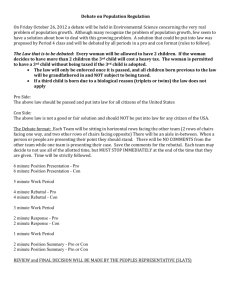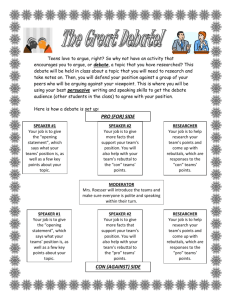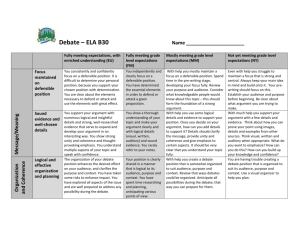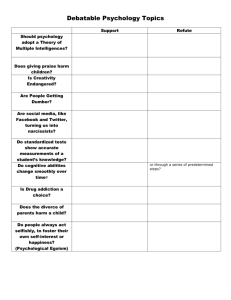Debating Technological Issues
advertisement
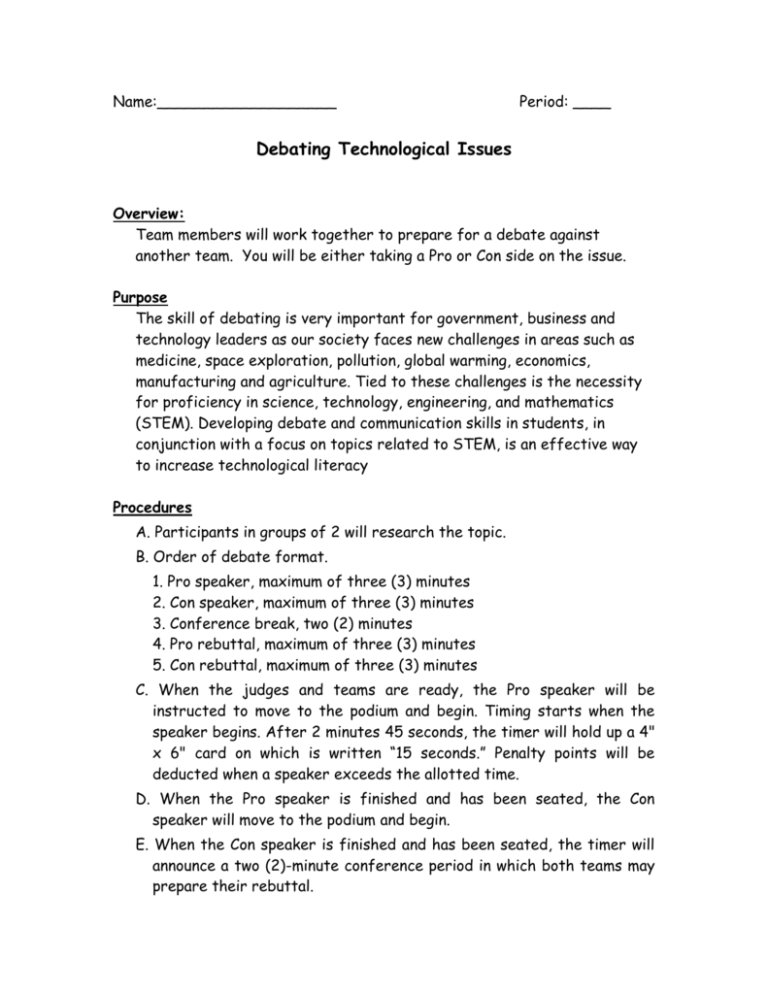
Name:___________________ Period: ____ Debating Technological Issues Overview: Team members will work together to prepare for a debate against another team. You will be either taking a Pro or Con side on the issue. Purpose The skill of debating is very important for government, business and technology leaders as our society faces new challenges in areas such as medicine, space exploration, pollution, global warming, economics, manufacturing and agriculture. Tied to these challenges is the necessity for proficiency in science, technology, engineering, and mathematics (STEM). Developing debate and communication skills in students, in conjunction with a focus on topics related to STEM, is an effective way to increase technological literacy Procedures A. Participants in groups of 2 will research the topic. B. Order of debate format. 1. Pro speaker, maximum of three (3) minutes 2. Con speaker, maximum of three (3) minutes 3. Conference break, two (2) minutes 4. Pro rebuttal, maximum of three (3) minutes 5. Con rebuttal, maximum of three (3) minutes C. When the judges and teams are ready, the Pro speaker will be instructed to move to the podium and begin. Timing starts when the speaker begins. After 2 minutes 45 seconds, the timer will hold up a 4" x 6" card on which is written “15 seconds.” Penalty points will be deducted when a speaker exceeds the allotted time. D. When the Pro speaker is finished and has been seated, the Con speaker will move to the podium and begin. E. When the Con speaker is finished and has been seated, the timer will announce a two (2)-minute conference period in which both teams may prepare their rebuttal. F. At the conclusion of the two (2)-minute conference period, the timer will announce that the conference period is over and the Pro rebuttal speaker will approach the podium. Timing starts when the speaker begins. After 2 minutes 45 seconds, the timer will hold up a 4" x 6" card on which is written “15 seconds.” Penalty points will be deducted if a speaker exceeds the allotted time. G. Participants will give the judges a one (1)-page list of reference materials used to research the debate subtopics. This reference list must be a word-processed document that can be printed on both sides of a sheet of paper. MLA format must be used in citing resources. A copy of the reference summary should be made and turned into the judges each time a team competes. Regulations A. Participants must debate the topic assigned. B. Pre-written notes may be used. Notes must be written on 3" x 5" notecards. C. Notes may be taken during the debate. D. A three (3)-ring binder of reference material, as noted on the reference list provided to the judges, may be used during the debate. E. No audio-visual materials of any form may be used. J. Teams are penalized for speaking over the allotted time. See the official rating form for time deductions. K. Each team is required to submit a summary of references (used to prepare for the event) on an 8½" x 11" sheet of paper; both sides of the paper may be used. The event topic, and group member names must be printed at the top of the front side of the paper. The reference summary must be word-processed (handwritten is not acceptable). MLA format must be used to cite sources. References for subtopics should be submitted on one (1) sheet of paper, not a separate sheet for each subtopic. Not having a summary of references will be a rules violations and participants will not be permitted to debate their topic. Evaluation Evaluation will be based upon a team’s knowledge of the topic and communication ability (i.e., the use of debate and presentation skills). CRITERIA Minimal performance 1-4 points Points of argument Team does not get the attention of the audience, and/or does not outline points clearly and distinctly. Team makes an effort to grab the attention of the audience; previewing points are somewhat organized in a logical manner. Organization Ideas may not be focused or developed; the main purpose is not clear; the introduction is undeveloped; main points are difficult to identify; transitions may be needed. The team does not have a grasp of the information; it cannot answer questions about the subject; inaccurate, generalized, or inappropriate supporting material is used; there is an over-dependence on notes. Delivery detracts from the message; eye contact may be very limited; presenter may tend to look at the floor, mumble, speak inaudibly, fidget, or read most of the speech; gestures and movements may be jerky or excessive. Rebuttal is unorganized, unclear, and/or incoherent; rebuttal includes no counter to points made from the opposing team. The main idea is evident but the organizational structure may need to be strengthened; ideas may not be clearly developed or always flow smoothly, and the purpose is not clearly stated; main points are not clear. The team has a partial grasp of the information; supporting material may lack in originality; the team is at ease with expected answers to all questions but fails to elaborate. Language choices may be limited, peppered with slang or jargon, too complex, or too dull; language is questionable or inappropriate for the audience. One team member does majority of the speaking and/or debating on the topic; the other student seems disengaged from the presentation. Topic knowledge Delivery Rebuttal Voice and language Group member participation Adequate performance 5-8 points Exemplary performance 9-10 points Introduction uses an attention getter, clearly states the thesis, previews main points of the team is cognizant of the audience, and enunciates well; the speaking is fluid. Ideas are clearly organized, developed, and supported; the purpose is clear; main points are clear and organized effectively. The team has a clear grasp of information; citations are introduced and attributed accurately; the team demonstrates full knowledge, with explanations and elaboration of the subject area. Delivery generally seems effective, however, good use of volume, eye contact, vocal control, etc. may not be consistent; some hesitancy may be observed; vocal tone, facial expressions, and/or other nonverbal expressions do not detract from the message Delivery is extemporaneous, natural, confident, and enhances the message; posture, eye contact, smooth gestures, facial expressions, volume, pace, etc. indicate confidence, a commitment to the topic, and a willingness to communicate. Rebuttal is somewhat organized, wordy and often incoherent, but it creates a mostly logical counter to the opposing team’s points. Rebuttal is logical, concise, and creative; counter arguments from the opposing team are each incorporated in the rebuttal in a unique and interesting way. Language used is mostly respectful or inoffensive; language is appropriate, but word choices are not particularly vivid or precise. Language is familiar to the audience, appropriate for the setting, and free of bias; language choices are vivid and precise. Both team members are engaged in the debate, but one student clearly takes the lead and allows the other student to only reply/ refute statements. Both team members are actively involved in the presentation, debate, and rebuttals of the topic, sharing responsibility throughout Start researching early Tackle the research head on. Start early and read everything that you can, the Topic Guides are essential. Don't just stick to your side of the argument though, read your opposition's articles and try and anticipate what they will attack you with. If you are already prepared for some responses, then you won't be wrong-footed as easily. However, don't rely on this and remember to work with the flow of the debate. Further reading is great too, read around the subject but be prepared to justify your points and cite your references for statistics. Chris Wakefield (Queen Elizabeth Sixth Form College, Darlington), alumnus, 2006/07 Statistics are good but… Use them to support your points but beware! It is very easy to find statistics from your perspective but be prepared to back them up with multiple sources and always cite your references and sources. It is very easy to become over reliant on them, so don't depend on them. There is a good balance between arguments and evidence, so try and aim for a good mix with statistics only when needed. Chris Wakefield (Queen Elizabeth Sixth Form College, Darlington), alumnus, 2006/07 Know your argument Know your argument, but be flexible with it. It is quite possible that somebody will offer a new perspective on your argument. This does not necessarily directly contradict what you have said, but might prove a good discussion point. The ability to respond to these new ideas, while linking them to your original argument, will demonstrate the ability to listen, think, and respond to different points. James Metcalfe (Queen Elizabeth Sixth Form College, Darlington), alumnus, 2006/07 Read the news Talk about current issues with friends and relatives. If you keep generally up to date with the news and current affairs, this might be relevant in one of the future debates and helps to get your mindset into a debating and critical one, which I found very useful. Practicing with your team is also good, our team did this a lot anyway before we even started debating and it can be quite interesting and thought provoking to hear and respond to other people's opinions. INFO: Works cited help http://owl.english.purdue.edu/owl/
